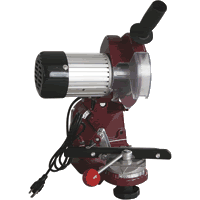Dai Sensei
ArboristSite Member
My chain vice is a vice for sharpening (as well as jointing and cutting) the teeth on hand saws but it works well for chains as well. The vice is held vertical by a large woodworking vice on my woodworking bench. With such a long bed I only have to rotate my chain 3 times on a the chain that fits my 42" bar. The other thing is that the extra height brings sharpening up to a comfortable height - also I have crap eyesight so I wear a head mounted magnifier to sharpen
The tap handles set into the bottom of the vice provide additional leverage/force on the top clamp than is possible with the middle thru bolts.
Nice one Bob. I especially like the tap handles, you obviously have access to cheap plumbing supplies






